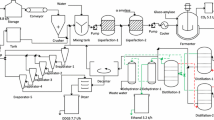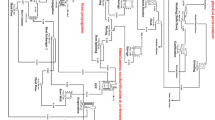Abstract
This study investigates the effect of varying cost and process parameters on bioethanol production rate and the minimum bioethanol selling price (MBSP) during large-scale production of second-generation bioethanol from Sila sorghum stalks found in Kenya. Aspen Plus was used to model and simulate the process that was considered in this study. The flow rate of biomass was varied between 10,000 and 300,000 kg/h which gave rise to a bioethanol flow rate of between 2134.49 and 62,707.33 kg/h. Bioethanol production rate decreased from 21,759.5 to 19,397.6 kg/h when the feed stage position in the beer column increased from 2 to 8. MBSP increased from $0.81/L to $1.11/L when the cost of biomass was varied from $20/tonne to $100/tonne. MBSP increased from $0.9/L to $1.0/L when the cost of enzymes was varied by − 50% and + 50%. MBSP increased from $0.83/L to $1.54/L when discount rate varied by 5% and 30%. MBSP increased from $0.85/L to $1.06/L when fixed capital investment was varied by -35% and + 35%. MBSP reduced from $1.28/L to $0.95/L when plant life varied from 10 to 30 years. MBSP increased from $0.89/L to $0.99/L when income tax rate varied from 0 to 40%. The study indicates that second-generation bioethanol is able to compete with gasoline in Kenya when no levies and taxes are imposed on the MBSP, at a plant life of 15 years and beyond and at an income tax rate of between 0 to 40%.



(Source: Table 8)

(Source: Table 9)

(Source: Table 10)

(Source: Table 11)

(Source: Table 14)

(Source: Table 16)

(Source: Table 17)
Similar content being viewed by others
Data Availability
The article contains all the relevant data. The corresponding author would provide any additional data upon request.
Abbreviations
- 2GBE:
-
Second-generation bioethanol
- DCFROR:
-
Discounted cash flow rate of return
- DPC:
-
Direct production cost
- EPRA:
-
Energy and petroleum regulatory authority
- FCI:
-
Fixed capital investment
- IRR:
-
Internal rate of return
- kg/h:
-
Kilogram per hour
- kmol/h:
-
Kilomole per hour
- kW:
-
Kilowatt
- LGB:
-
Lignocellulosic biomass
- l/min:
-
Liters per minute
- MBSP:
-
Minimum bioethanol selling price
- NPV:
-
Net present value
- PFD:
-
Process flow diagrams
- Q:
-
Heat quantity
- RadFrac:
-
Rigorous distillation
- Rstoic:
-
Stoichiometric reactor
- SHCF:
-
Separate hydrolysis and co-fermentation
- SSCF:
-
Simultaneous saccharification and co-fermentation
- TCI:
-
Total capital investment
- TPC:
-
Total product cost
- $:
-
United States of America dollar
- WCI:
-
Working capital investment
References
Dias, M.O.S., Cunha, M.P., Jesus, C.D.F., Rocha, G.J.M., Pradella, J.G.C., Rossell, C.E.V., Bonomi, A.: Second generation ethanol in Brazil: compete with electricity production. Bioresour. Technol. 102, 8964–8971 (2011)
Mustafa, B., Havva, B., Cahide, O.: Progress in bioethanol processing. Prog. Energy Combust. Sci. 34, 551–573 (2008)
Kumar, R., Tabatabaei, M., Karimi, K., Sárvári, H.I.: Recent updates on lignocellulosic biomass derived ethanol—a review. Biofuel Res. J. 9, 347–356 (2016)
Sims, R.E.H., Mabee, W., Saddler, J.N., Taylor, M.: An overview of second-generation biofuel technologies. Bioresour. Technol. 101, 1570–1580 (2010)
Hector, H., Hughes, S., Liang-Li, X.: Developing yeast strains for biomass to ethanol production. Ethanol Producer Magazine, June 2008 Issue (2008)
Mosier, N., Wyman, C., Dale, B., Elander, R., Lee, Y.Y., Holtzapple, M., Ladisch, M.: Features of promising technologies for pretreatment of lignocellulosic biomass. Bioresour. Technol. 96, 673–686 (2005)
Li, Q., He, Y., Xian, M., Jun, G., Xu, X., Yang, J.: Improving enzymatic hydrolysis of wheat straw using ionic liquid 1-ethyl-3-methyl imidazolium diethyl phosphate pretreatment. Bioresour. Technol. 100, 3570–3575 (2009)
Salimi, M.N., Lim, S.E., Yusoff, A.H., Jamlos, M.F.: Conversion of rice husk into fermentable sugar by two stage hydrolysis. J. Phys. Conf. Ser. 908, 012056 (2017)
Svetlana, N., Jelena, P., Ljiljana, M.: Challenges in bioethanol production: utilization of cotton fabrics as a feedstock. Chem. Ind. Chem. Eng. 22, 375–390 (2016)
Chang, V.S., Holtzapple, M.T.F.: Fundamental factors affecting biomass enzymatic reactivity. Appl. Biochem. Biotechnol. Res. 84, 5–37 (2000)
Kumar, P., Barrett, D.M., Delwiche, M.J., Stroeve, P.: Methods for pretreatment of lignocellulosic biomass for efficient hydrolysis and biofuel production. Ind. Eng. Chem. Res. 48, 3713–3729 (2009)
Zhang, Y.P., Lynd, L.R.: Towards an aggregated understanding of enzymatic hydrolysis of cellulose: non complexed cellulase systems. Biotechnol. Bioeng. 88, 797–824 (2004)
Afsahi, B., Kazemi, A., Kheirolomoom, A., Nejati, S.: Immobilization of cellulase on non-porous ultrafine silica particles. Sci. Iran. 14(4), 379–383 (2007)
Lili, W., Xiaoyan, Y., Jing, S.: Immobilization of cellulase in nano fibrous PVA membranes by electrospinning. J. Membr. Sci. 250, 167–173 (2005)
Muktham, R., Bhargava, S.K., Bankupalli, S., Ball, A.S.: A review on 1st and 2nd generation bioethanol production—recent progress. J. Sustain. Bioenergy Syst. 6, 72–92 (2016)
Joshi, B., Bhatt, M.R., Sharma, D., Joshi, J., Malla, R., Sreerama, L.: Lignocellulosic ethanol production: current practices and recent developments: review. Biotechnol. Mol. Biol. 6, 172–182 (2011)
Tan, K.T., Lee, K.T., Mohamed, A.R.: Role of energy policy in renewable energy accomplishment: the case of second-generation bioethanol. Energy Policy 36, 3360–3365 (2008)
Agfax On-line: Super Sorghum: high yielding and drought tolerant. http://www.agfax.net (2011)
Mailu S.K., Mulinge, W.: Excise tax changes and their impact on Gadam sorghum demand in Kenya. In: 5th International Conference of AAAE, United Nations Conference Centre, Addis Ababa, Ethiopia, 23–26th September (2016)
Lopes, T.F., Cabanas, C., Silva, A., Fonseca, D., Santos, E., Guerra, L.T., Sheahan, C., Reisa, A., Girioa, F.: Process simulation and techno-economic assessment for direct production of advanced bioethanol using a genetically modified Synechocystis sp. Bioresour. Technol. Rep. 6, 113–122 (2019)
Boakye-Boaten, N.A., Kurkalova, L., Xiu, S., Shahbazi, A.: Techno-economic analysis for the biochemical conversion of Miscanthus x giganteus into bioethanol. Biomass Bioenergy 98, 85–94 (2017)
Aspen Plus: Aspen Plus User Guide, Version 10.2. Aspen Technology, Inc., Cambridge, MA (2000)
Tgarguifa, A., Abderafi, S., Bounahmidi, T.: Modeling and optimization of distillation to produce bioethanol. Energy Procedia 139, 43–48 (2017)
Zhao, L., Zhang, X., Xu, J., Ou, X., Chang, S., Wu, M.: Techno-economic analysis of bioethanol production from lignocellulosic biomass in China: dilute-acid pretreatment and enzymatic hydrolysis of corn stover. Energies 8, 4096–4117 (2015)
da Silva, A.R.G., Ortega, C.E.T., Rong, B.G.: Techno-economic analysis of different pretreatment processes for lignocellulosic-based bioethanol production. Bioresour. Technol. 218, 561–570 (2016)
Porzio, G.F., Prussi, M., Chiaramonti, D., Pari, L.: Modeling lignocellulosic bioethanol from poplar: estimation of the level of process integration, yield and potential for co-products. J. Clean. Prod. 34, 66–75 (2012)
Quintero, J.A., Moncada, J., Cardona, C.A.: Techno-economic analysis of bioethanol production from lignocellulosic residues in Colombia: a process simulation approach. Bioresour. Technol. 139, 300–307 (2013)
PIEA. Petroleum Institute of East Africa: quarterly industry report on petroleum sale in Kenya, Nairobi, PIEA (2019)
Dalberg. Scaling up clean cooking in urban Kenya with LPG & bio-ethanol, a market and policy analysis (2018)
Ministry of Energy Kenya: National Energy Policy. Kenya Government Press, Nairobi (2018)
Kazi, F.K., Fortman, J.A., Anex, R.P., Hsu, D.D., Aden, A., Dutta, A., Kothandaraman, G.: Techno-economic comparison of process technologies for biochemical ethanol production from corn stover. Fuel 89, S20–S28 (2010)
Aspen Plus V8.4. AspenTech Inc., Burlington, MA (2013)
Barreraa, I., Amezcua-Allieri, M.A., Estupinan, L., Martínez, T., Aburtob, J.: Technical and economical evaluation of bioethanol production from lignocellulosic residues in Mexico: case of sugarcane and blue agave bagasses. Chem. Eng. Res. Des. 107, 91–101 (2016)
Humbird, D., Davis, R., Tao, L., Kinchin, C., Hsu, D., Aden, A.: Process Design and Economics for Biochemical Conversion of Lignocellulosic Biomass to Ethanol Dilute-Acid Pretreatment and Enzymatic Hydrolysis of Corn Stover. National Renewable Energy Laboratory Golden, Golden (2011)
Ngigi, W.T.: Optimizing the conversion of pretreated sila sorghum stalks to simple sugars using immobilized enzymes. Int. Res. J. Eng. Technol. 4, 1–5 (2017)
Sinnott, R.K.: Coulson and Richardson, Chemical Engineering Design, vol. 6, 3rd edn. Butterworth-Heinemann Linacre House, Oxford (2002)
EPRA: Clarification on the high petroleum pump prices for the period 15th March to 14th April 2021, Press release, Nairobi (2021)
Tgarguifa, A., Abderafi, S., Bounahmidi, T.: Energy efficiency improvement of a bioethanol distillery, by replacing a rectifying column with a pervaporation unit. Renew. Energy. 122, 239–250 (2018)
Frankó, B., Galbe, M., Wallberg, O.: Bioethanol production from forestry residues: a comparative techno-economic analysis. Appl. Energy. 184, 727–736 (2016)
Osborne, S.: Energy in 2020: assessing the economic effects of commercialization of cellulosic ethanol, office of competition and economic analysis, manufacturing and services competitiveness report (2007)
Republic of Kenya: The Income Tax Act (CAP 470). Kenya Government Press, Nairobi (2021)
Li, H., Liu, H., Li, S.: Feasibility study on bioethanol production by one phase transition separation based on advanced solid-state fermentation. Energies 14, 6301 (2021)
Piccolo, C., Bezzo, F.: A techno-economic comparison between two technologies for bioethanol production from lignocellulose. Biomass Bioenergy 33, 478–491 (2009)
Acknowledgements
The authors are grateful to Africa Development Bank (AFDB), Africa Centre of Excellence (ACEII-PTRE), and Moi University, Kenya, for supporting this work financially.
Author information
Authors and Affiliations
Corresponding author
Ethics declarations
Conflicts of interest
The authors declare that they have no conflicts of interest.
Additional information
Publisher's Note
Springer Nature remains neutral with regard to jurisdictional claims in published maps and institutional affiliations.
Appendix 1
Appendix 1
See Tables 4, 5, 6, 7, 8, 9, 10, 11, 12, 13, 14, 15, 16, and 17.
Rights and permissions
About this article
Cite this article
Ngigi, W., Siagi, Z., Kumar, A. et al. Predicting the techno-economic performance of a large-scale second-generation bioethanol production plant: a case study for Kenya. Int J Energy Environ Eng 14, 95–108 (2023). https://doi.org/10.1007/s40095-022-00517-1
Received:
Accepted:
Published:
Issue Date:
DOI: https://doi.org/10.1007/s40095-022-00517-1




